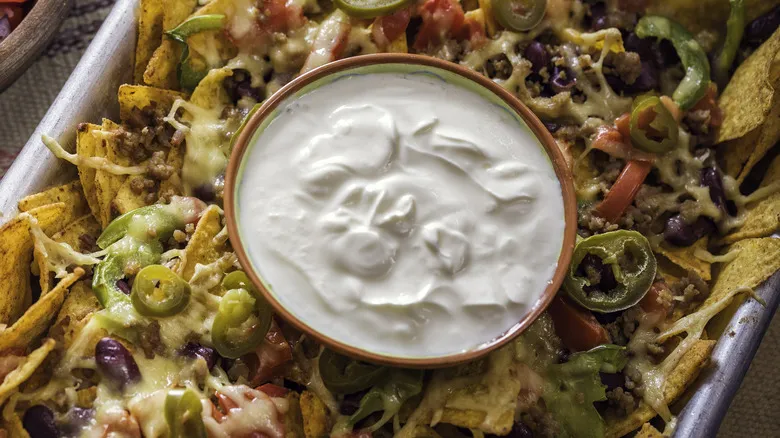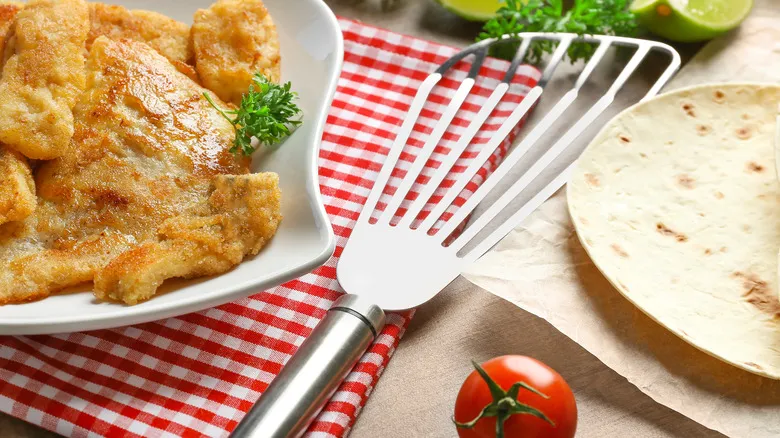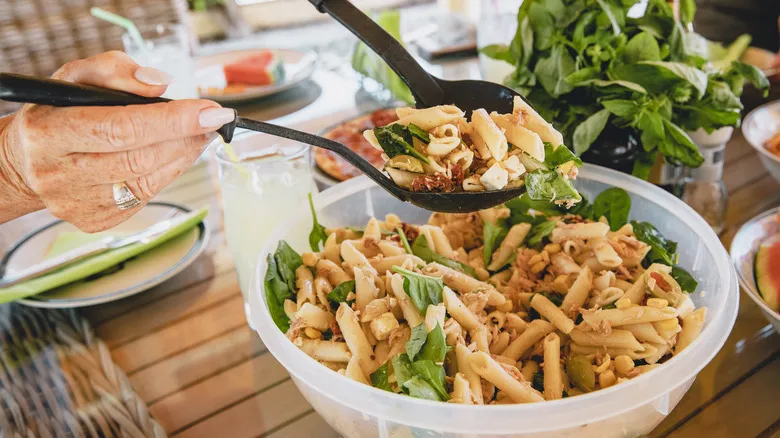Add plenty of ingredients

The Barefoot Contessa, Ina Garten, is well-acquainted with summer salads, having crafted, refined, and sold them at her specialty food shop in the Hamptons, New York. One of her most beloved recipes is a pasta salad that features generous amounts of ingredients like feta, tomatoes, and olives. Unlike some pasta salad recipes that skimp on cheese and vegetables, Garten's version boasts a full pound of tomatoes and a pound of feta, paired with just half a pound of pasta. She also incorporates two varieties of tomatoes—fresh and sun-dried—to enhance the flavor profile. This pasta salad is designed to be flavorful at every stage, from the chopped components to the dressing, which is Garten's secret to avoiding a dull, ordinary pasta salad.
When demonstrating the preparation, Garten suggests starting with warm pasta. This allows the noodles to soak up the flavors, particularly from the homemade dressing. She creates the dressing by pureeing sun-dried tomatoes in a food processor with vinegar, olive oil, capers, and ample seasoning, which she also includes in the salad. After draining the pasta, Garten adds the sun-dried tomatoes first, followed by fresh tomatoes and olives. She then mixes in the dressing, Parmesan, and parsley before tossing everything together. Garten believes in using plenty of ingredients, as this enhances the flavor of the pasta salad, preventing it from being bland. She finishes by sprinkling salty feta crumbles just before serving.
Make a flavorful dressing

The dressing plays a crucial role in pasta salad, influencing the flavor of each bite. Ree Drummond's sunshine pasta salad features lemon juice and lemon zest to infuse a refreshing brightness into a mayo-based dressing. Recognizing the dressing's significance, she begins by showing how to prepare it and shares her technique for ensuring it adheres to every piece of pasta. Drummond starts by mixing equal parts mayo and sour cream, then adds Dijon mustard, lemon zest, and lemon juice to create the vibrant flavor that distinguishes this dish. She also incorporates grated garlic, salt, and pepper to enhance the overall taste of the dressing.
In contrast to some chefs who suggest adding dressing to warm pasta, Drummond prefers to mix hers with pasta that has cooled. She uses only about two-thirds of the dressing she made, allowing her to toss the entire salad and reserve some dressing for later adjustments.
Like many chefs, Drummond encourages a generous approach to ingredients. In her sunshine pasta salad, she includes a colorful array of red, orange, and yellow vegetables, such as bell peppers and halved cherry tomatoes, to add visual appeal and a burst of fresh flavor. She completes the dish with a lemon garnish that complements the sunny theme and echoes the zesty dressing.
Use interesting pasta shapes

Giada De Laurentiis emphasizes the importance of pasta when selecting the perfect ingredients for a delicious pasta salad. She incorporates unique pasta shapes and vibrant colors to enhance her creations, like the fusilli noodles featured in her tricolor pasta salad. These spiral noodles not only maintain their shape but also add visual appeal with their yellow, orange, and green hues. While the flavor remains unchanged, this playful presentation adds an element of surprise to the dish.
To elevate her pasta salad, De Laurentiis includes tomatoes, cheese, basil, and arugula, recommending that the entire mixture be generously coated with dressing to ensure every noodle and ingredient is well-covered. She also suggests grating Parmesan cheese right after draining the pasta, which helps the sauce and dressing adhere better.
Pasta with ridges can hold more dressing and ingredients in each bite, a clever technique that can transform a simple salad into something exceptional. De Laurentiis' picnic pasta can be made with any short pasta, such as fusilli, elbow, or the less common casarecce, as these shapes effectively hold dressing and blend seamlessly with other components. Short pasta is also more fork-friendly, allowing for a delightful combination of flavors and textures in every bite, which is what makes pasta salads so appealing.
Mix the dressing thoroughly

Rachael Ray suggests utilizing a food processor to ensure that all ingredients are well blended when preparing your dressing. You definitely want to avoid a situation where a bite of dressing lacks essential flavors or where garlic, onion, or spices are concentrated in one area. In her Italian pasta salad, Ray starts with a base of vinegar and vegetable broth, adding grated garlic and chopped parsley. As the mixture processes, she gradually pours in olive oil, allowing it to emulsify properly. Since oil and vinegar don’t naturally combine and can separate if not emulsified slowly, this careful approach to dressing is crucial.
In her pesto penne pasta salad, Ray emphasizes the importance of coating each noodle with a rich pesto dressing that features vibrant herbs, lemon zest, garlic, cheese, and toasted pine nuts. Similar to her other dressing recipes, she slowly streams olive oil into the food processor while making the pesto, ensuring an even incorporation.
Roast peppers for extra flavor and tenderness

In her whole wheat pasta salad, Alex Guarnaschelli enhances the dish by roasting red peppers over an open flame, then chopping them and incorporating them into the mix for added sweetness and texture. While she prefers red bell peppers, yellow, orange, or green varieties can also be used. Charring the peppers over an open flame intensifies their natural sweetness. You can control the level of char by adjusting how long they are exposed to the flame.
To char the peppers, place them directly over the flame of your gas stove, or use a grill or open fire. As they cook, the skin will blister and blacken, so be sure to rotate the peppers frequently to ensure even charring. Once they reach your desired level of doneness, remove them from the flame and let them cool on a plate; it may take a few tries to get it just right. After cooling, slice the peppers open and discard the seeds. Guarnaschelli suggests wiping away the blackened bits with a kitchen towel, although she often leaves a bit of char for a subtle crunch and added flavor. The resulting peppers will be tender yet crisp, making them a delightful addition to your pasta salad once diced or sliced and mixed with the other ingredients.
Think outside the pasta box

Bobby Flay incorporates couscous, a tiny hand-rolled pasta, as a substitute for classic pasta shapes like penne or macaroni in his pasta salad. This choice adds an unexpected twist to traditional pasta salad recipes and pairs well with a range of flavors. Couscous cooks quickly, although the most traditional methods can be labor-intensive, resulting in a light and fluffy base for your salad. Its small size allows it to blend seamlessly with other ingredients. You can enhance its flavor by adding various components and easily coat the entire dish with dressing, but be cautious not to overdo it, as this could lead to a watery outcome. Flay includes grilled vegetables and fresh mozzarella to achieve the ideal pasta salad blend, suggesting a rough chop for the vegetables to add texture to the dish.
Couscous comes in several varieties, but they all share the common trait of being small, rolled pasta shapes typically made from wheat or barley. Moroccan couscous is the smallest of the three most popular types and serves as a base for dishes that are usually served over rice. Israeli couscous, often referred to as pearl couscous due to its pearl-like shape, is slightly larger and is ideal for cold salads. Lebanese couscous is a bit bigger than pearl couscous but remains small enough to mix well, making it a great option for pasta salad as well.
Use vinaigrette dressing

When you think of pasta salad, mayo-based dressings often come to mind, but a vinegar-based dressing can provide a refreshing and delightful twist. Geoffrey Zakarian opts for a vinaigrette instead of the heavier mayo to create a lighter pasta salad. His dressing features a blend of vinegar and mustard as a base, enhanced with grilled scallions, salt, and pepper for added flavor. Zakarian grills the scallions until they are slightly charred, then chops them and incorporates them into the dressing. He adds the cooked pasta directly to the vinaigrette before mixing in any other ingredients, ensuring that every noodle is thoroughly coated.
Fresh tomatoes, olives, red onion, and an abundance of fresh herbs contribute to a bright and light flavor profile. Provolone cheese adds a touch of creaminess without overpowering the dressing. This pasta salad is a much lighter alternative to mayo-based versions and doesn't require the same strict temperature control when serving. However, since it contains cheese, it's best to store it in the refrigerator.
Embrace ingredients with heat

Even a plain macaroni salad can be transformed with some creative add-ins that introduce a whole new flavor experience to this simple dish. In his aptly named mac-daddy-roni salad, Guy Fieri incorporates roasted peppers, diced bell peppers, and pepperoncini, along with a zesty dressing that brings a complex flavor profile with a kick. Fieri is no stranger to bold flavors, as he also adds hot sauce to his garlic bread and sautéed onions and peppers to his Zing Zang flank steak. If you're looking to spice up your macaroni salad, take his advice to elevate this classic dish.
It all starts with a dressing that goes beyond just basic mayo. While it begins with mayonnaise, it gains an extra zing from mustard, vinegar, and garlic, preserving the creaminess of traditional macaroni salad while enhancing it significantly. The excitement continues with the addition of vegetables. Fieri includes red onion, roasted red peppers, pickled peppadew peppers, and crunchy veggies like carrots and celery. All ingredients are finely diced or minced to ensure they blend seamlessly. This mix of crunch, heat, and tang, combined with the vinegar and pickled peppers, creates a rich depth of flavor that truly shines. This pasta salad tastes even better after resting in the fridge overnight.
Opt for salad dressing to save time

You can create your own dressing by combining mayo, vinegar, sugar, and seasonings, or you can choose a pre-made salad dressing that has the ideal blend of ingredients. Sunny Anderson suggests that using a store-bought dressing can save you time and make preparing pasta salad even simpler. Her pea pasta salad features ranch dressing, which brings together flavors of onion, dill, parsley, and garlic. While making your own dressing is an option, store-bought varieties are a convenient alternative when you're pressed for time. Additionally, a ready-made dressing is versatile and can be stored in the fridge for later use on salads or as a dip.
Ranch dressing is a great choice for cold pasta salads and complements other ingredients like chicken, bacon, and cheese. Many pasta salads typically use a vinaigrette, whether homemade or store-bought. To enhance your pasta salad, consider adding a bit more dressing after it has chilled and just before serving. This will help rehydrate the pasta, which tends to absorb some of the dressing as it cools. It’s even more convenient if you’re using a store-bought dressing that’s kept in the fridge alongside the salad. Plus, if you find you need a little extra, you can easily pop out to the store to replenish your supply.
Follow a formula

Martha Stewart suggests adhering to a straightforward formula for pasta salads. Start with something fresh, add something green, incorporate something briny or salty, include something acidic, and finish with something creamy, all paired with your choice of pasta. She advises opting for short noodles over long ones, as they are easier to eat. Dried pasta is preferable since it holds up better against the dressing without becoming soggy.
This approach allows Stewart to whip up a delicious pasta salad even without a specific recipe, enabling her to utilize the freshest ingredients available at the market. You can also explore your pantry and fridge to make the most of what you already have or personalize your pasta salad by following this formula to blend your favorite flavors. This reliable method is a great way to create a unique dish for any gathering, allowing you to play with themes, such as using ingredients of the same color or from a particular region.
Toast nuts to give extra flavor

This preparation technique utilizes ingredients you likely already have, enhancing their flavor with a simple step. Gordon Ramsay toasts pine nuts before incorporating them into his orzo pasta salad. You can apply this method to any raw nuts, with various options like almonds, walnuts, and peanuts available pre-roasted at the store. Pine nuts are particularly favored due to their high oil content, which produces a rich, nutty flavor when toasted. Roasting them on the stovetop is an excellent approach, as it allows for easy monitoring, though the microwave and oven are also viable alternatives.
Toasting pine nuts takes just a few minutes, so keep a close eye on them, as they can quickly transition from raw to burnt. Ramsay adds the toasted pine nuts to the salad while the pasta is still slightly warm, allowing the flavors to meld. Pine nuts complement basil beautifully, which is what Ramsay incorporates into his pasta salad, along with a dressing of olive oil and Parmesan. Toasted pine nuts and basil also create a delightful combination in Rachael Ray's pesto sauce, which she uses in her pasta salad.
Recommended

Old Onion Sacks Will Get Your Dishes Cleaner Than Ever

The Last Day You Can Still Use Sour Cream After Opening It

The KitchenAid Attachment That Makes Homemade Bread (Almost) Effortless

To Flip The Most Delicate Foods, Pick Up A Fish Spatula
Next up

